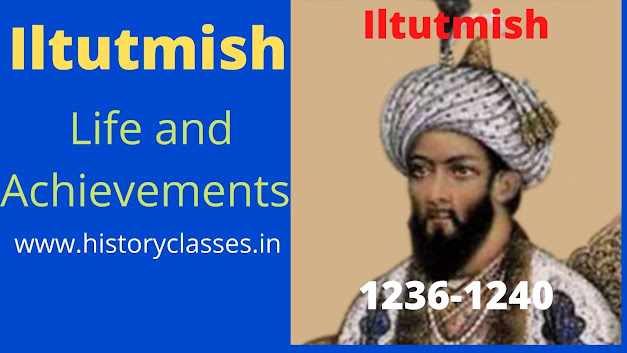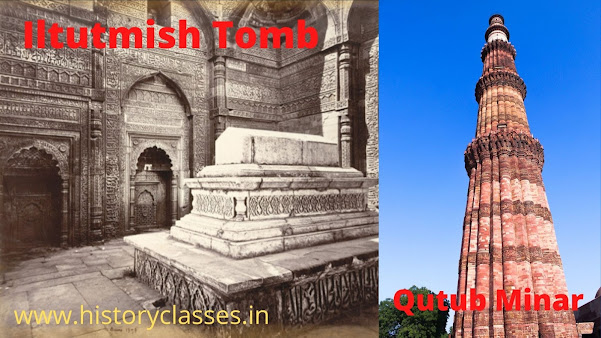After the death of Qutubuddin Aibak, the first sultan of the Das or Slave dynasty in 1210 AD, the Maliks and Sardars in Lahore installed a person named Aramshah to maintain peace among the people and prevent possible rebellions. There are differences of opinion as to what was the relationship between Aramshah and Qutubuddin. The people of Delhi refused to accept this weak and incompetent ruler and an atmosphere of planetary war was created in the country.
In such a situation, an invitation was sent to Iltutmish, the Subedar of Badaun and son-in-law of Qutubuddin Aibak, to handle the situation in Delhi. Iltutmish, accepting the invitation, left for Delhi and defeated Aramshah in place of “JUD” which put him to death, and became the third Sultan of Delhi. Today in this blog we will discuss the life and achievements of this Iltutmish.
Iltutmish: Early Life
Iltutmish (Shamsuddin Iltutmish) was a slave and was the most eligible Sultan among the sultans of the Das dynasty. We have no proof of when he was born. But Iltutmish was born in Turkistan. He was born into a high family. He belonged to the Turkish Ilbari community. He was very handsome and of sharp intellect in his childhood. Her other brothers were jealous of her beauty and her intelligence and tried to deprive her of her paternal residence and patronage.
His brothers sold it to a merchant from Bukhara who sold it to another person from where Qutubuddin Aibak bought it. Seeing his military qualities and leadership ability, Qutbuddin Aibak appointed him as the province president of Badaun.
Iltutmish’s father’s name was Eelam Khan, a tribal chieftain
Where did Iltutmish live?
Iltutmish was a resident of Turkistan who was sold by a person to Qutubuddin Aibak.
Who was the wife of Iltutmish
Seeing the talent of Iltutmish, Qutbuddin Aibak married Honi’s daughter to Iltutmish. Shah Turkan had another wife who was the mother of Ruknuddin Firozshah, a Turkish maidservant.
Iltutmish Subedar of Badaun
Qutbuddin Aibak appointed Iltutmish as the Subedar of the ‘Akta’ (Jagir) of Badaun. At that time, Badaun was the highest in the Delhi Empire.
When did Iltutmish get Freedom from Slavery?
Muhammad Ghori was greatly impressed by Iltutmish with his commendable services and Ghori freed him from slavery by an order. Thus he was not a slave at the time of becoming the Sultan.
Iltutmish as the Sultan of Delhi
After the death of Qutbuddin Aibak in 1210 AD, Aram Shah ascended the throne of Delhi. Aramshah turned out to be a weak and incompetent ruler, in such a situation Iltutmish was invited by the chieftains to get the power of Delhi. Iltutmish defeated Aramshah and captured the throne of Delhi and became the third ruler of the Delhi Sultanate.
Iltutmish Protest
Iltutmish’s becoming the ruler was challenged by a general of Qutubuddin but he failed. Some Islamic jurists led by Qazi Wajih-Ud-din opposed him on the ground that he was a slave and a slave could not become a sultan. These people calmed down only when Iltutmish showed them his slavery emancipation.
Did Iltutmish kidnap Delhi Sultanate?
It is alleged that Iltutmish was not the real heir of the Delhi Sultanate and had abducted it. But this allegation cannot be agreed upon as there was no such thing as kidnapping. He was invited by the Sardars of Delhi himself. He had gained power by conquest and was also recognized by the Caliph of Baghdad.
The Caliph of Baghdad conferred on Iltutmish the title of Sultan-e-Azam (Great Ruler). On his coins, Iltutmish depicted himself as the messenger of the Caliph.
Iltutmish’s Difficulties
When Iltutmish became the Sultan in 1211 AD, there were many challenges in front of him. But he bravely faced those difficulties and challenges and overcame them. He immediately took drastic measures against the Qutbi and Muizzi Maliks and inflicted oppressive defeat on them near Delhi. Consolidated his position in Delhi and its surrounding areas. He also obtained the ‘Mukti Patra’ from Yalduj.
Face of Yldauz
Tajuddin Yalduj became the ruler of Ghazni after Muhammad Ghori, he considered the Delhi Sultanate to be a part of the Ghazni Empire. That was the biggest challenge for Iltutmish. Yalduz captured Lahore in 1214 AD. The situation was intolerable for Iltutmish. Yalduj also captured Punjab and Thaneshwar. Iltutmish reached the plain of Tarain (1215-1216 AD) to teach Yalduz and defeated Yalduz badly.
Yaldoz was captured in an injured condition and taken to Badaun where he was murdered. In this way, Iltutmish got freedom from his biggest enemy.
Problem of Kabcha
Nasiruddin Qubacha was the provincial head of ‘Uch’ and ‘Multan’. After the death of Qutbuddin Aibak, Qubacha declared himself independent and also took control of the Punjab part. To punish the rebellious Qubacha, Iltutmish expelled him from Punjab in 1217 AD. But in the next, he tried to be independent again.
In 1227 AD Iltutmish marched against Qubacha and took control of ‘Uch’. Kubacha fled and took refuge in ‘Bhakkar’ but in the end, he committed suicide. Iltutmish captured Bhakkar and appointed Vazir Muhammad Junaid for the conquest of Sindh.
Bengal’s Problem
After the death of Qutbuddin, Ali Mardan assumed the title of Alauddin, establishing independent power in Bengal. After his death, his son Hisamuddin Ibaz Ghiyasuddin ascended the throne with the title of Azim and issued coins in his name.
He also read the Khutba of his name. This was an intolerable situation for Iltutmish, so in 1225 a campaign was sent against him and Ghiyasuddin himself led him immediately accepted the submission of Iltutmish and agreed to pay the tax. But after some time he rebelled again, this time he was defeated by Iltutmish and put to death and took Bengal under the direct control of the Delhi Sultanate.
Problem of Rajputs
After the death of Qutbuddin Aibak, most of the Rajputs had established their independent power and expelled the Muslim armies from their kingdoms. Iltutmish could not bear the independence of the Rajputs for long so he sent his forces to control the Rajputs.
* First of all, Ranthambore was conquered in 1226 AD.
After that, the siege of Jailor was laid. The ruler Udai Singh protested there but in the end, he surrendered and was allowed to continue as the ruler on the condition of paying taxes.
Biana, Tanger, Ajmer, and Jodhpur were also captured.
* In 1231 AD, the ruler of Gwalior defeated Malaya Vammardev and returned to the kingdom only after paying taxes.
The ruler of Kalinjar, Trilokyavarma gave up his kingdom, due to which looting started in the state. But the Chandelas drove the Muslim armies out of the state.
Iltutmish himself led the invasion of Nagad, but there the ruler Kshetra Singh defeated him, due to which Iltutmish had to suffer a lot.
Iltutmish also failed to defeat the Chalukyas of Gujarat.
* In 1234-35 Iltutmish attacked Malwa. He plundered in Bhelsa and Ujjain. Destroyed the famous Mahakal temple of Ujjain.
Problem of Doab
Many districts of present-day Uttar Pradesh – Kannauj, Banaras, Katehar (Rohilkhand), Bahraich, and Awadh, etc. had established independent power after the death of Qutubuddin Aibak. But Iltutmish brought all the districts of the Doab under the Delhi Sultanate.
Mongols’ Problem
The Mongols were very cruel and terrible people. Iltutmish had to face the Mangol problem during his reign. For the first time in 1221 AD, the Mongols under the leadership of their dreaded leader Genghis Khan appeared on the banks of the Sindh River. When Genghis Khan attacked Jalaluddin Mangbarni, the last ruler of Khwajam, he fled to Punjab and sought refuge in Iltutmish.
Sensing the crisis, Iltutmish sent a written decree to Jaluddin that there was no objection to sheltering him but the climate of Punjab would not prove suitable for him. Jalaluddin made a treaty with the Khokars, he defeated Nasiruddin Qubacha of Multan and returned back after plundering. The Mongols also returned. Thus the small Muslim kingdom of India was saved.
How did Iltutmish die?
Iltutmish’s last campaign was against Bamiyan. This region was located just west of the mountainous region or the Salt Range of the Sindh-Sagar Doab. On the way, Iltutmish was struck by a very high fever so he had to come back to Delhi. Eventually, the fever proved so fatal that Iltutmish died on 30 April 1236.
Achievements of Iltutmish
- In 1231-32 AD, the construction work of Qutub Minar was completed.
- Qutub Minar is named after Khwaja Qutubuddin who came to India for residence.
- Iltutmish had arranged a bell and chain in his court so that the seeker of justice could easily reach the Sultan in times of difficulty.
- In the Sultanate period, the person seeking justice had to wear red clothes.
- Iltutmish got the construction work of a school done in Delhi.
- Roads were built and forests cleared.
- Iltutmish is also credited with possibly getting the first tomb built in India.
- Iltutmish got the Jama Masjid of Badaun and the gate of Atarkin constructed in Nagaur. ‘
- The mosque of Ajmer was built by Iltutmish.
- Iltutmish’s tomb is located in Delhi, which is an orbital tomb.
- Iltutmish formed a group of 40 powerful slave Turks in his court, which was known as Turk-i-Chalgani.
Iltutmish’s capital
Iltutmish shifted his capital from Lahore to Delhi. After that, all the Sultans kept Delhi as their capital.
Coins of Iltutmish
Iltutmish was the first Sultan to issue coins in pure Arabic script.
Iltutmish accepted the silver ‘Tanka’ (Rupee Ancestor) as his standard coin, whose weight was equal to 175 grains.
Made ‘Jital’ of ‘copper’.
Iltutmish started the tradition of getting the mint’s name inscribed on the coins.
On coins, Iltutmish mentions himself as the representative of the Caliph.
After the Gwalior conquest, Iltutmish got some proud words inscribed on his coins, such as “the mighty sultan”, “the sun of empire and religion”, and “the assistant of the hero of the devout”.
Iltutmish introduced the ‘Iqta system’.
Iltutmish’s successor
Iltutmish had three sons and one daughter. He had four children, Nasiruddin Mahmud, Ruknuddin Firoz, Razia Sultan, and Muddin Bahram.
All his sons were luxuriant and unworthy due to which he declared Razia Sultan as his successor. But after the death of Iltutmish, the noble chieftains rejected Razia’s succession and placed Ruknuddin Firoz Shah on the throne.
Iltutmish’s assessment
Sir Woolsley Hague has ranked Iltutmish as the best among the slave sultans. He organized and expanded the empire he received from his master. Established the empire and provided stability. He was cruel to Hindus.
Minhaj-us-Siraj praised him as a wise, kind, virtuous, and religious man. Minhaj-us-Siraj composed Tabat-i-Nasiri. Many other scholars lived in his court.
- जहांगीर की जीवनी और उपलब्धियां: प्रारम्भिक जीवन, विद्रोह, साम्राज्य विस्तार, नूरजहां विवाह, न्याय जंजीर और कला संरक्षक
- भारत में मस्जिदें: भारत में 15 प्राचीन मस्जिदें,इस्लामी स्थापत्य कला
- बाबर का इतिहास: प्राम्भिक जीवन, कठिनाइयां, पानीपत का युद्ध, भारत विजय, साम्राज्य विस्तार, मक़बरा, उपलब्धियां और मृत्यु
- क्या मुग़ल सम्राट हिन्दू धर्म विरोधी थे -Religious policy of Mughal emperors from Babar to Aurangzeb
- https://studyguru.org.in
- http://www.histortstudy.in


